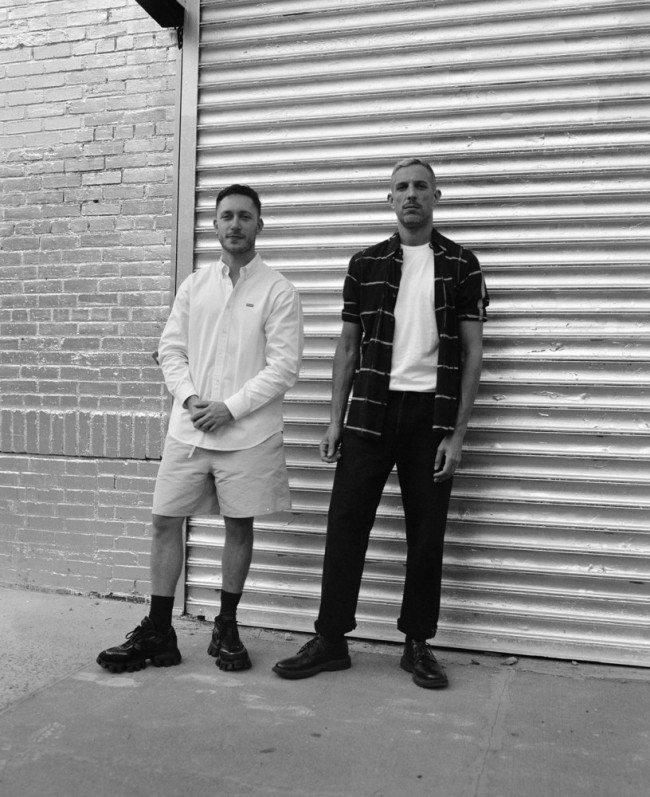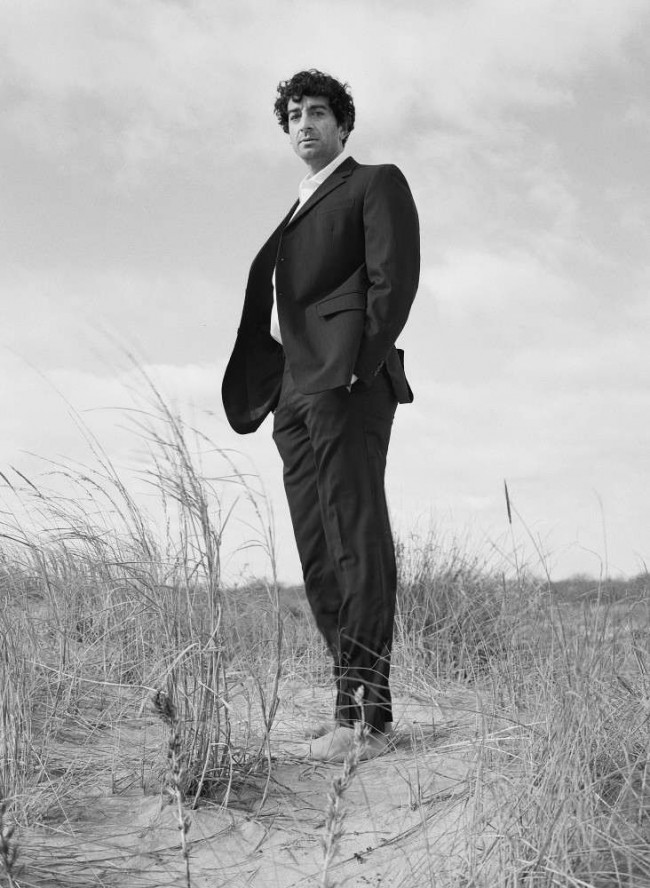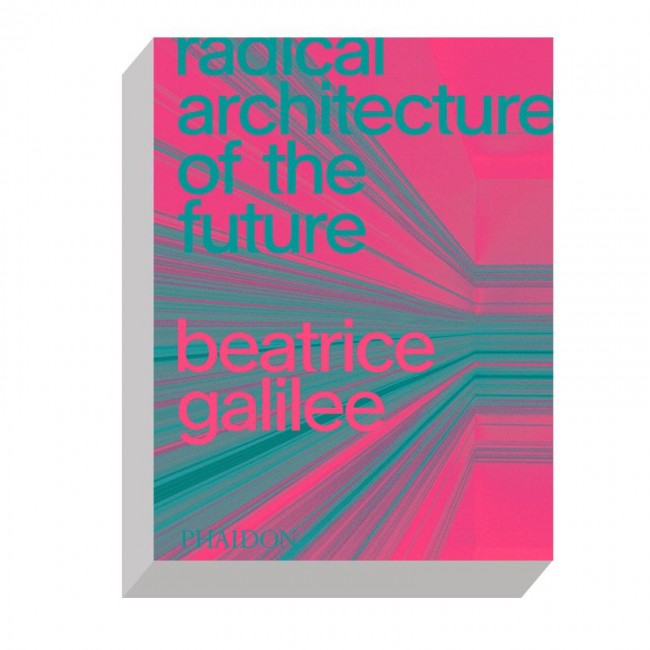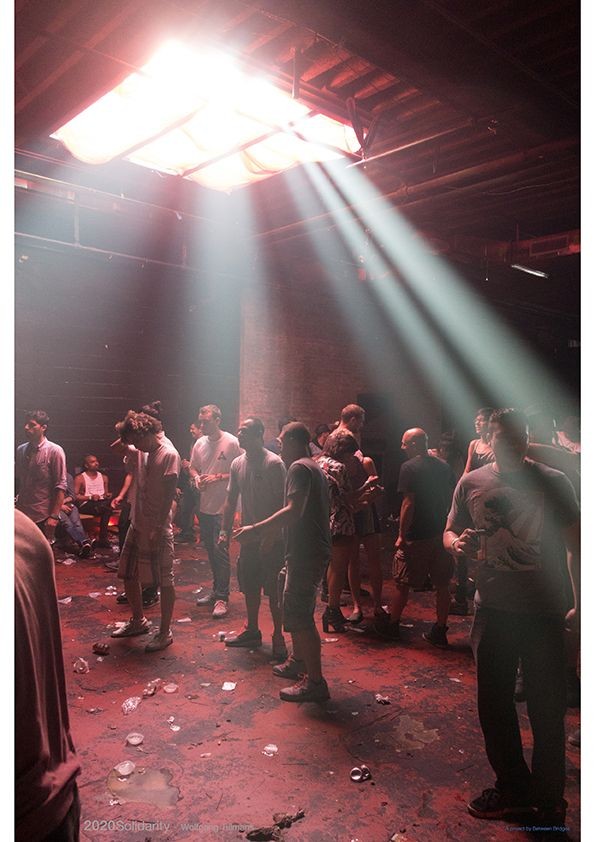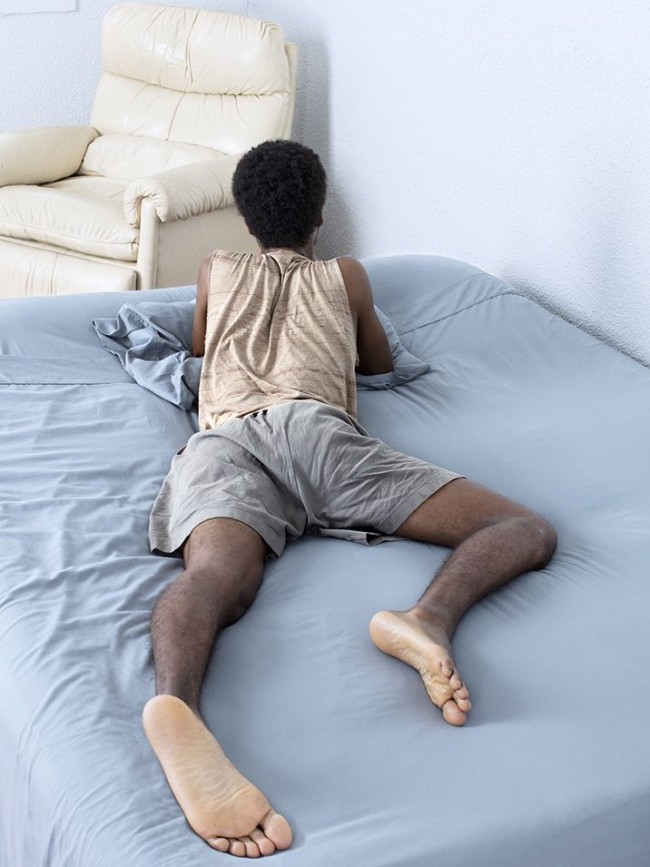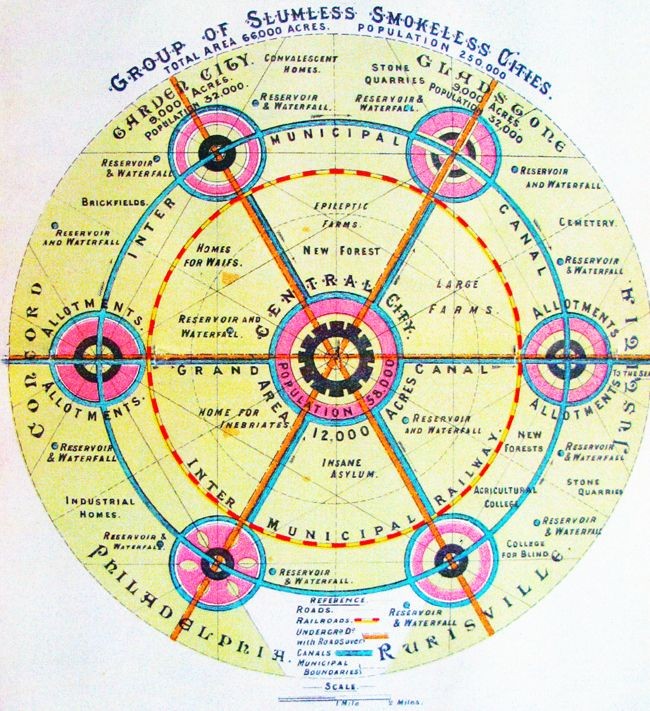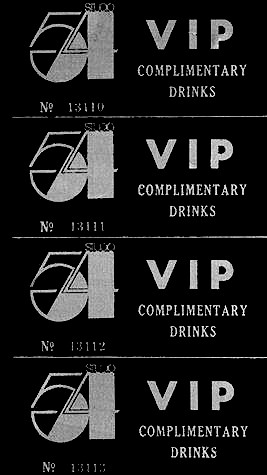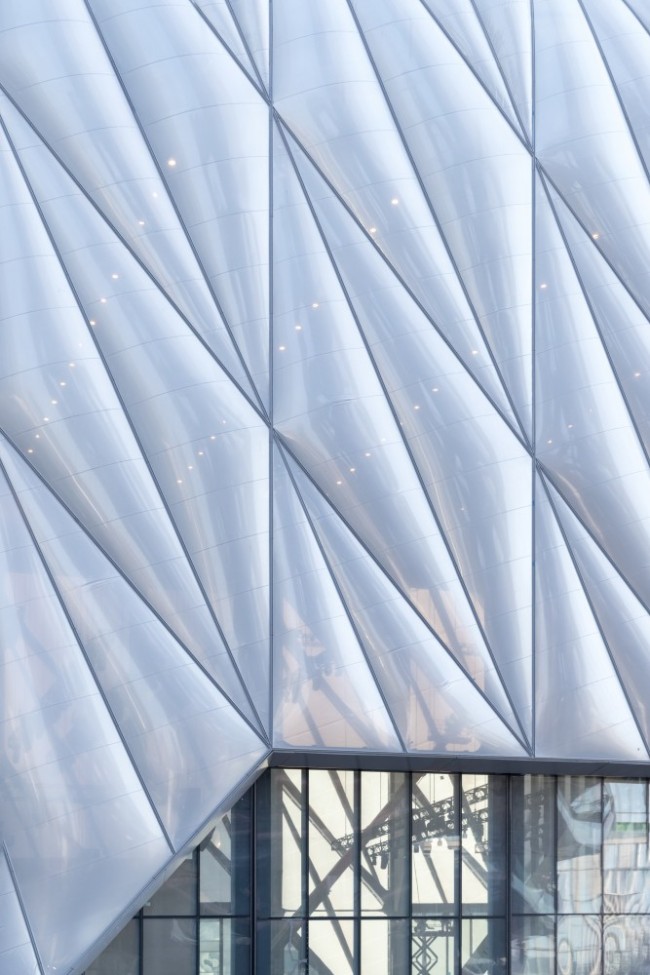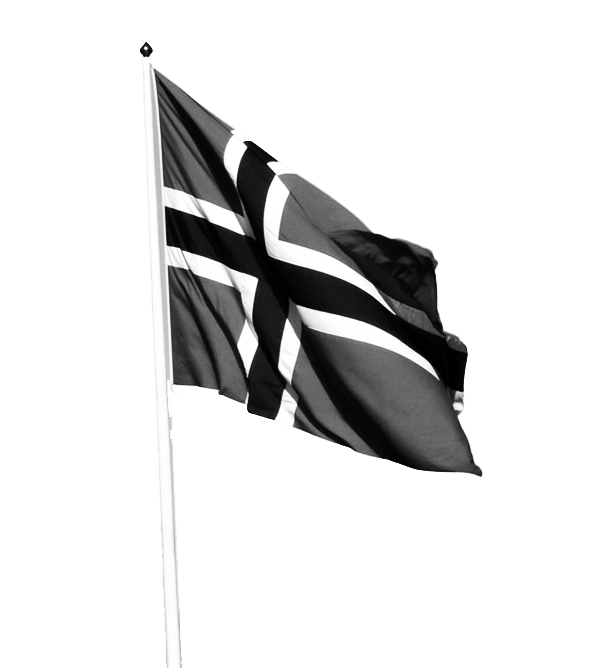Cruising Pavilion considers the Architecture of Queer Sex, from Grindr to Glory Holes
-

Cruising Pavilion visual essay by Rasmus Myrup (2019). Courtesy of Cruising Pavilion
-

Cruising Pavilion visual essay by Rasmus Myrup (2019). Courtesy of Cruising Pavilion
-

Cruising Pavilion visual essay by Rasmus Myrup (2019). Courtesy of Cruising Pavilion
As a Catholic teen in the mid 90s, my gay coming of age started in the aftermath of the AIDS crisis, which cast a terrifying shadow on a sexuality that was already considered socially unacceptable. Gay men in the small Massachusetts suburban town where I lived were exclusively closeted. There was no public space officially designated for us to meet each other. Like most of those living outside cities in those pre-Internet days, the only way I could experience the encounters I longed for was to choose high-risk public sex. I almost instinctively learned that the I-95 highway rest stop, the Emerald Square Mall bathrooms, and the steam room at Gold’s Gym were where I could connect with my kind. I didn’t know how or why, but even at 15, I understood those places were for sex. Living in a heteronormative society where monogamy was the law of the land, the fundamental pursuit of satisfying my libido defined me as a sexual outlaw, a status that came with equal pride and shame. I couldn’t fully contemplate the factors that had pushed me into those spaces or how my participation in them had formed my sexual psychology. I just believed that anonymous public encounters were what we, my fellow deviants and I, naturally deserved, and I learned to fetishize the thrill. In 1997, Aaron Betsky’s book Queer Space was published, examining the disregarded histories of disenfranchised sexual minorities who were forced to carve out their own spaces within a hostile mainstream society. This was the first academic declaration that the sociological phenomenon known as cruising was of value to architectural theory and practice.
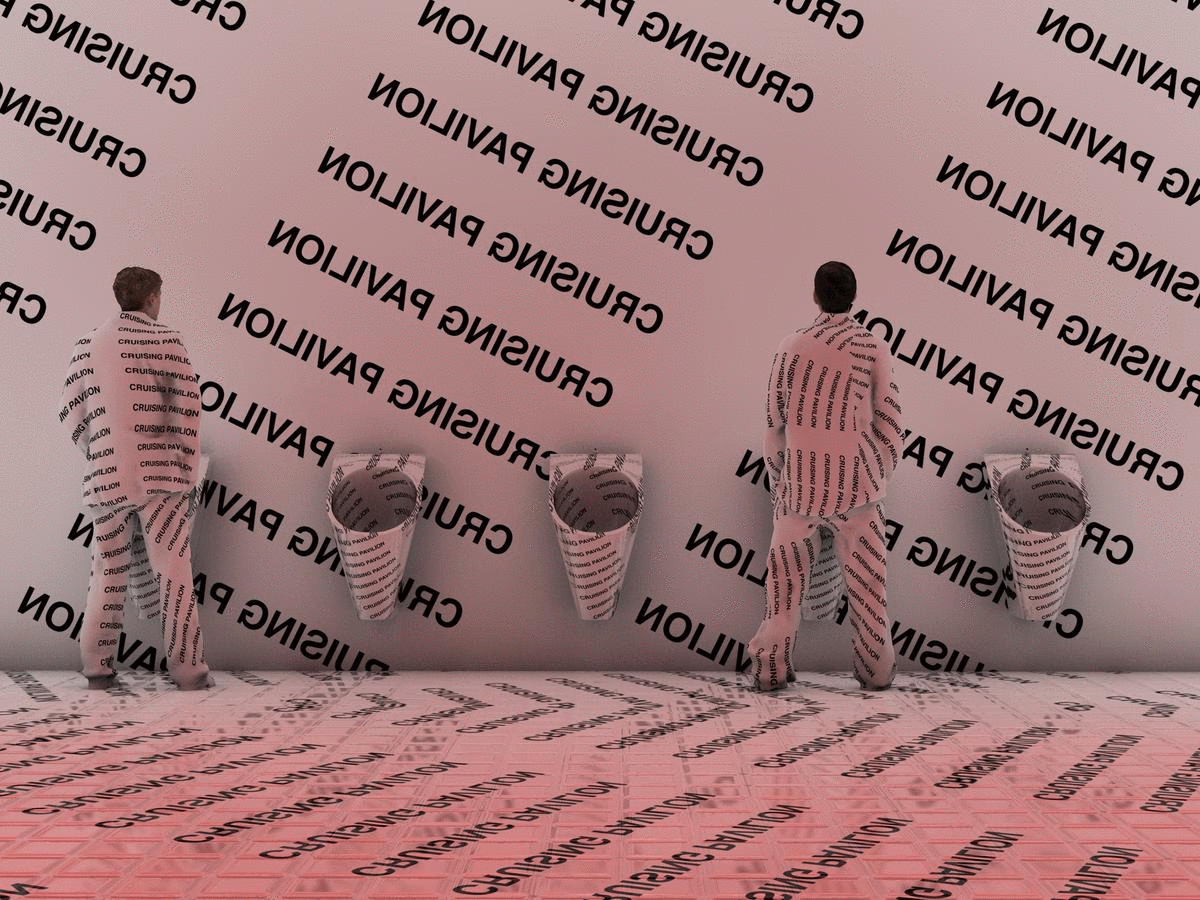
Cruising Pavilion visual essay by Rasmus Myrup (2019). Courtesy of Cruising Pavilion
Two decades after Betsky’s landmark publication and half a century since the Stonewall riots, a series of exhibitions titled Cruising Pavilion explores the history of gay sex in public space and the changing character of anonymous encounters in the new millennium. My teenage self could not have imagined a future in which I would be able to discuss these activities publicly, let alone view a series of high-profile international exhibitions investigating them. While the gay mainstream today increasingly pushes to be embraced by conservative and historically exclusive institutions (marriage, military, religion), the team behind Cruising Pavilion — artist/curator Rasmus Myrup, architect/writer Octave Perrault, and the collaborative duo of curators/art critics Charles Teyssou and Pierre-Alexandre Mateos — focused their project on an activity that will never politely align with the quest for heterosexual assimilation. Over the last two years, they’ve dedicated three exhibitions in three different countries to the subject of cruising — the pursuit of sex with strangers — a topic that has never before been given curatorial consideration within the world of architecture. In many countries, over many decades, and often at great risk to themselves (physical danger, blackmail, arrest), queer people have carved out space for their sexual pursuits both by adoption (public restrooms, bathhouses, gym saunas) and by design (gay bars, nightclubs). Though the text is never explicitly mentioned, the Cruising Pavilion exhibitions expand on Betsky’s Queer Space, updating its thesis to align with a millennial worldview informed by the Internet, marriage equality (at least in many Western countries), and the game-changing HIV-pre-exposure-protection pill PrEP, and expanding his definition of queer beyond gay men to include lesbian, trans, bi-sexual, gender-non-conforming, and non-binary definitions of identity. These relatively recent developments allow the curators to approach a once-taboo topic without the stigma and shame that were pervasive less than a generation ago.

Cruising Pavilion curators Pierre-Alexandre Mateos, Octave Perrault, Charles Teyssou, Rasmus Myrup (from left to right) with ArkDes curator James Taylor Foster (bottom right). Photography by Frida Vega Salomonsson.
Each edition of Cruising Pavilion, which traveled from Venice to New York to Stockholm, presents cruising’s past and present while hinting at its possible futures. The curators show how the gay community has adopted public space, designating particular public bathrooms and specific areas of parks, as well as intentionally designed gay bars, nightclubs, bath houses, sex clubs, and digital platforms, for sexual encounters. The exhibitions bring together art — films, videos, drawings, photography — and artifacts — historical memorabilia, architectural drawings and models, design objects — that highlight the sociological forces — religion, politics, economics, disease, technology, and medicine — that impacted how cruising cultures developed from the 1950s until today.
VENICE, ITALY
Venice’s canals and densely packed buildings form an elaborate maze of tiny alleys that became a cruising utopia in the days of Proust and inspired gay classics like Thomas Mann’s Death in Venice. Today the city is so completely saturated by tourist families that the only cruising is done by ships in the canals. Still, it was here in 2018 that the Cruising Pavilion curators began their project, as a rogue addition to the most important architectural exhibition in the world, the Venice Architecture Biennale. Coincidentally, their chosen subject auspiciously aligned with the theme of that edition of the biennial, which was titled Freespace. Even in an era when major cultural institutions are making a concerted effort to include the stories of marginalized communities, the official Biennale included no mention of cruising, a practice that is perhaps the most comprehensive reimagining of city space by a minority group. True to cruising’s outlaw spirit of co-opting, Myrup, Mateos, Perrault, and Teyssou appropriated the naming structure of the biennial — each country showcases its brightest talents in a national pavilion (the Greek Pavilion, the Canadian Pavilion, etc.) — declaring that in a biennial dedicated to free space, cruising demanded its own presentation. The Cruising Pavilion curators also “perverted” the biennial’s official manifesto written by Yvonne Farrell and Shelley McNamara, replacing every instance of the word “freespace” with “cruising.” They found the resulting composite text perfectly defined their intentions: “Freespace Cruising can be a space for opportunity, a democratic space, un-programmed and free for uses not yet conceived. There is an exchange between people and buildings that happens even if not intended or designed…”
-

Representation of of Diller Scofidio + Renfro’s Blur Building (2002) as part of Cruising Pavilion’s 2017 Venice iteration. Photography by Louis de Belle. Courtesy of Cruising Pavilion.
-

-

-

Representation of Studio Karhard Boiler Club-extension (2015), as part of Cruising Pavilion’s inaugural Venice edition in 2018.
On opening night, hundreds of curious attendees made the trek on the vaporetto from the Giardini, where the official pavilions are located, to the far end of the island of Giudecca, where Cruising Pavilion was staged. Dimly lit with a red glow, the hosting arts venue Spazio Punch took on the ambience of a sex club with a previous exhibition’s mezzanines and narrow stairways further setting the mood and suggesting the possibility of clandestine encounters. As I made my way through the show, I became aware just how much exhibition design and cruising clubs have in common: both are essentially mazes that guide visitors though semi-secluded areas, allowing them to search for unexpected fulfillment through engagement with unknown entities, whether art or bodies. In this rare case, both were possible.
At the entrance to the exhibit, a moodboard-esque timeline paid homage to cruising classics such as a Tom of Finland ink cartoon depicting a leather-clad man heading to a “Pleasure Park,” and an image of Peter Berlin, the German-born artist and porn actor who became a fixture of the 1970s San Francisco scene, and is widely regarded as the patron saint of cruising. As I made my way through the show, I was reminded of something Berlin said in an interview with Hans Ulrich Obrist for a forthcoming artist’s monograph (which, full disclosure, I edited). Summing up how cruising has changed, Berlin declared that “it went from a great spontaneous outdoor scene with public sex happening everywhere to something you make an appointment for, as you would to visit a doctor.” But the post-Grindr transformation of hookup culture wasn’t the only transition the exhibition examined. With architectural models of Barcelona sex clubs by Spanish architects Pol Esteve and Marc Navarro Fornós, the curators presented common spatial strategies used by sex-club entrepreneurs when designing spaces that “foster a dynamic where fantasy and pleasure are in constant negotiation,” while their inclusion of a video showcasing Diller Scofidio + Renfro’s Blur Building (2002), designed for Switzerland’s Expo.02, suggested how cruising-specific architectural strategies have been applied to facilitate more mainstream socialization — a temporary open-air pavilion built over Lake Neuchâtel, the Blur Building cloaked its visitors in a manufactured cloud, creating the same level of anonymity and freedom one experiences in a steam room. A rendering of S H U I, a speculative future spa by WangShui and Sean Roland designed for “all people but especially focused on those that have been excluded from gendered wellness spaces,” gestured at queer culture’s recent movement toward inclusivity, considering spaces that facilitate cruising for more people than just gay men, while Atelier Aziz Alqatami’s addition to the show was one of the exhibition’s few windows into cruising outside of a Western context. Alqatami’s video (Fenestra) (2018) offers rare documentation of cruising practices in his homeland, Kuwait, where, instead of meeting on foot, men seduce each other on the highway through motorcycle tricks or flashy cars. Viewing Dawson’s 20-Load Weekend (2004), a seminal piece of pornography directed by Max Sohl for Treasure Island Media, seemed shocking in a public setting with a design audience present, even given the show’s theme. Depicting a man engaging in bareback anal intercourse with 20 anonymous partners, the film caused a scandal when it was released because, for a generation brought up with two decades of militant safe-sex messaging, bareback sex, especially with multiple partners, was the ultimate taboo. “To properly address the topics of space and sexuality, we could not ignore pornography’s crucial role in gay representation. We chose this film because of its role in helping destigmatize men living with HIV,” explains Teyssou. The work also illustrated an element of queer architecture’s spatial history, since “monitors screening porn are often the only light in dark rooms.”
-
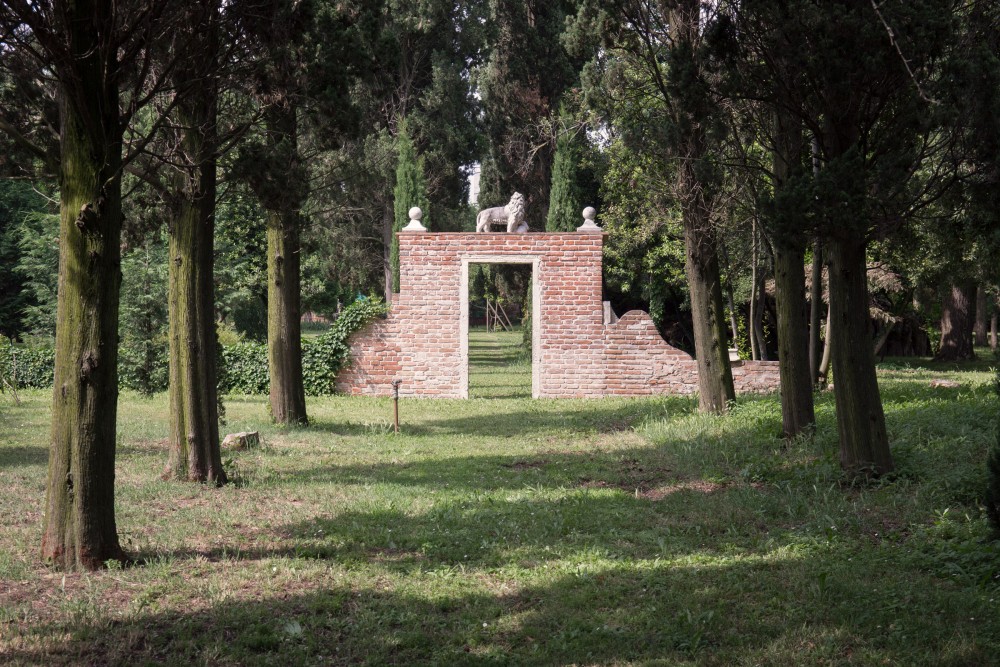
The Garden of Eden in Venice, Italy, which opened for private tours for Cruising Pavilion.
Photography by Louis De Belle. -

-

The Venice art space where Cruising Pavilion was staged sits just blocks away from the Garden of Eden, which served as a notorious cruising ground from the end of the Belle Époque until the Second World War. Popular among the cultural elite of the day, it has been celebrated in French and Italian literature, such as Gabriele D’Annunzio’s novel The Flame and Jean Cocteau’s poem “Souvenir d’un soir d’automne au jardin Eaden.” Here the exhibition was supplemented with a rare tour of the now private garden led by the only openly heterosexual Cruising Pavilion curator, Perrault, who explained that the park had been frequented by luminaires such as Henry James, Marcel Proust, and Cocteau. A piece of literary gossip: the garden was where a three-way love triangle began between a young Cocteau, the dilettante Raymond Laurent, and his American friend Langhorn Whistler. It was one of the tour’s many anecdotes that made me realize just how much cruising history and gay history are one and the same.
NEW YORK CITY, USA
In its second incarnation, in February 2019, the Cruising Pavilion curators were invited by the Goethe-Institut New York to take over their Manhattan gallery space, Ludlow 38. New York City, a former cruising paradise, was a hotbed of activity in the 70s and 80s with three bustling focal points: Time Square, the then-derelict warehouses of Chelsea Piers, and an area of Central Park known as the Ramble. It is also, of course, home to one of the most important queer spaces of all time, the Stonewall Inn. Here the Pavilion team went local, showing work by the city’s contemporary artists as well as presenting the histories of gay venues both realized and not. They stayed away from the icons of New York gay art — Félix González-Torres, Keith Haring, Robert Mapplethorpe, Andy Warhol — and instead focused on contributions from a new generation, among them DeSe Escobar, Kayode Ojo, Carlos Reyes, and Robert Yang. Like in Venice, the small Lower East Side gallery was dimly lit, this time with a blue glow, offering a similar aesthetic experience to the cruising venues it celebrated.
-

Cruising Pavilion, New York installation at Ludlow 38 in New York City. Courtesy Cruising Pavilion.
-

Cruising Pavilion, New York installation at Ludlow 38 in New York City. Courtesy Cruising Pavilion.
-
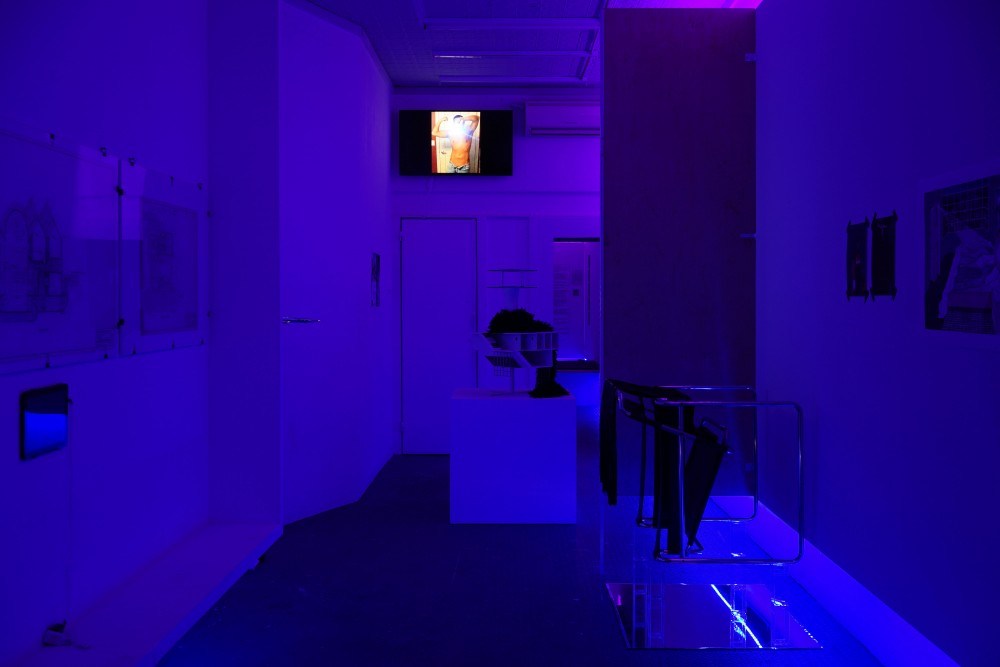
Cruising Pavilion, New York installation at Ludlow 38 in New York City. Courtesy Cruising Pavilion.
Upon entering, I was greeted by three early 70s architectural plans by Horace Gifford, a legend of gay architecture. After studying under master Louis Khan, Gifford almost exclusively applied his voyeuristic brand of queer Modernism — developed to enhance a hedonistic lifestyle — to building for his own community in the Fire Island Pines. These are some of the rare homes in mid-20th century America not created for nuclear families, and among the beach-house plans on display was a commission for designer Calvin Klein.
While the show referenced many projects for gay men that were actually built, the few lesbian spaces that were shown were never realized. The plans for one such project were originally published in the first issue of Out magazine in 1992: titled Lesbian Xanadu, the page layouts detailed the design for a tactile organic pleasure club developed by Amy Cappellazzo, Sarah Drake, Ann Krsul, and Alexis Roworth. Together they aimed to create a space that would challenge conventional capitalist class structures and gender norms. Patriarchal capitalism, in the form of the New York skyline, was the inspiration for two of the works on display: NYC Go-Go (Postcards from the Edge) (2014), a collage by Robert Getso, depicted a go-go boy scaled to skyscraper size dancing next to the Empire State building, the image queering the phallic tower’s association with straight-male ambition; it was complemented by Madelon Vriesendorp’s notorious 1975 Flagrant Délit showing the Empire State Building and Chrysler Building in bed together, with a third skyscraper breaking into the bedroom shining a flashlight on them, policing their behavior. Used on the cover of Rem Koolhaas’s Delirious New York, a book about how pleasure and decadence drove the city’s development, it was an image I’d seen countless times before. But it was only in the context of this exhibition that it became clear that these two skyscrapers are in fact intended to be read as a gay male couple, an epiphany that gave me newfound appreciation for Koolhaas and Vriesendorp’s famous tribute to the city that never sleeps.
-

Madelon Vriesendorp’s Flagrant Délit (1975) as part of the Cruising Pavilion, New York exhibition at Ludlow 38, New York. Courtesy Cruising Pavilion.
-

Cruising Pavilion, New York installation at Ludlow 38 in New York City. Courtesy Cruising Pavilion.
-

Cruising Pavilion, New York installation at Ludlow 38 in New York City. Courtesy Cruising Pavilion.
But the real highlight of the show for me came at the end, as I passed through a small hallway to reach the gallery’s dimly lit backroom — another instance of the show’s cruising-friendly design echoing its content. On the wall were blueprints for the members-only gay dance club The Saint, an ambitious addition to 1970s and 80s New York club design which the Cruising Pavilion curators describe as the “Teatro Olimpico of architecture’s sexual experiments… injecting poppers and LSD directly into the sensual production of space.” When the Saint opened in 1980, the club used these technical drawings of the redesigned building for its first invite, advertising the spatial appeal of a spectacular three-story “pleasure dome” and circular dance floor. Architect and co-owner Charles Terrell created the club’s fabulous design, which cost 13 million dollars when adjusted for inflation — one of the largest financial investments in the history of gay architectural space.

Scene from the opening reception for Re-Inauguration of The Bridge to Love, Lust, and Carnal Pleasure by Cruising Pavilion for their BOFFO Residency Fire Island (2019). Photography by An Pham.
In the wake of the New York exhibition, the Cruising Pavilion collective was invited to participate in the BOFFO Fire Island residency. There they rehabilitated the Bridge to Love, Lust, & Carnal Pleasure, a structure facilitating safe passage over a swampy portion of the Meat Rack, an infamous cruising area between two Fire Island towns, Cherry Grove and the Pines. The BOFFO residency also offered an opportunity for the curators to enjoy Gifford’s work firsthand and experience one of the only communities in America developed for and by gay people, designed with cruising as a central objective.
STOCKHOLM, SWEDEN
In Stockholm, in September 2019, Cruising Pavilion achieved its most prestigious staging at ArkDes, Sweden’s National Center of Design and Architecture. In a little less than two years, it has gone from a renegade operation to an institutionalized project shown in a national museum, though ironically it found its most distinguished venue in a city of 2.4 million people with only one official gay bar. Still, it’s fitting that Cruising Pavilion’s last chapter takes place in an actual pavilion, a structure called Boxen, housed inside one of the museum’s two main halls. Designed as a space for progressive programming by Dehlin Brattgård Arkitekter, with industrial finishings and a circular cut-out which, given the context, made me think of a giant glory hole, the room-within-a-room felt the perfect backdrop for the show’s radical subject matter.
-
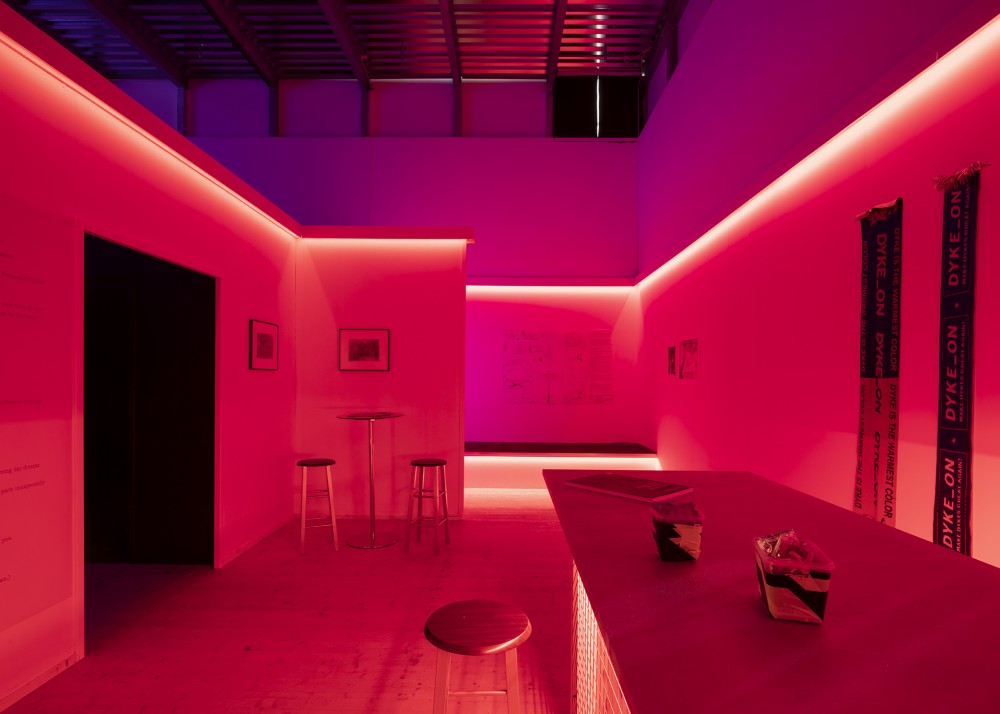
Installation view of Cruising Pavilion at ArkDes, Stockholm. Photography by Johan Dehlin.
-

Cruising Pavilion curators Octave Perrault, James Taylor-Foster (ArkDes), Rasmus Myrup, Pierre-Alexandre Mateos, and Charles Teyssou photographed by Frida Vega Salomonsson in front of the Boxen exhibition space at ArkDes in Stockholm.
-
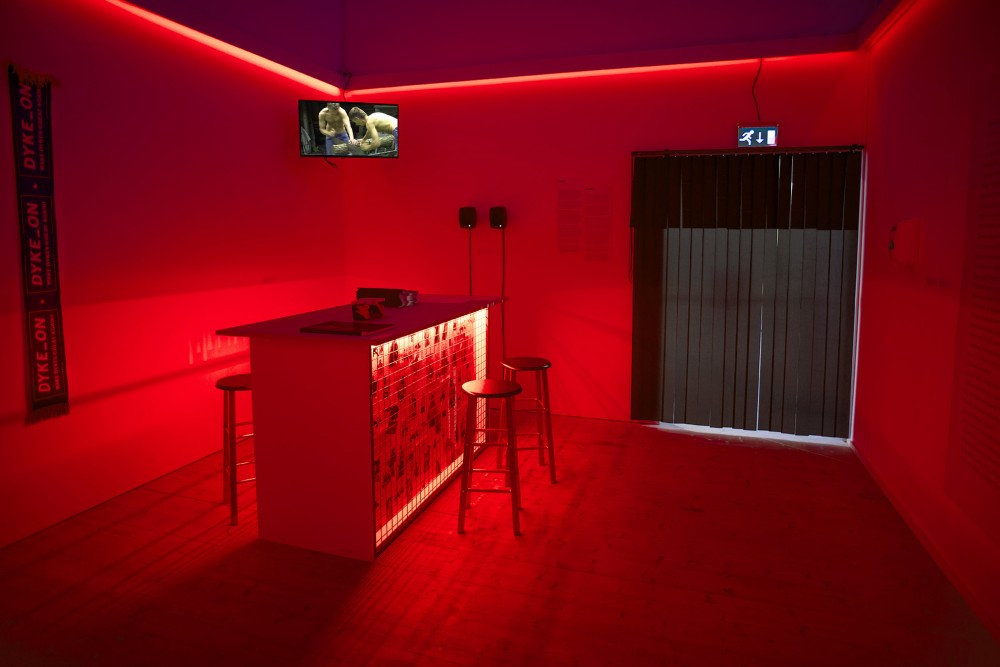
Installation view of Cruising Pavilion at ArkDes, Stockholm. Photography by Señor Image Studio.
Taking Cruising Pavilion into a national museum funded by taxpayers’ kronor sharpened questions about its relevance outside of its own subculture. On the morning before the exhibition opened, ArkDes curator of contemporary architecture and design, James Taylor-Foster (who after seeing the original show in Venice initiated bringing it to Stockholm), was worried about the possibility of the right-wing media exploiting individual pieces — such as Dawson’s 20-Load Weekend — for political purposes. His concerns made me realize just how much of a risk he was taking with this show, which the Cruising Pavilion curators insisted would not in any way be watered down to appease the general public. “In our first conversation, we told the museum there was no point in presenting a censored version of this exhibition,” explains Myrup. Attempting to address the illegality of showing pornography to minors, a wall text before entering explains that the show “contains explicit works depicting sex and is not recommended for people under the age of 15.”
During the opening night’s inaugural speeches, Perrault declared, “We are proud to have institutionalized a subject like cruising in architecture.” A heckler in the crowd — one of ArkDes’s largest vernissage audiences — shouted back, “FUCK YOU!” Caught off guard, Perrault diplomatically responded, “It’s true, there are pros and cons to being institutionalized, and I’m happy to discuss them with you in the darkroom.” And when they did in fact talk, Perrault was relieved to discover that the critic wasn’t a far-right zealot but a tantric-sex instructor who finds the word “institutionalized” to be triggering.
Inside Boxen, the Frankie Goes to Hollywood song “Welcome to the Pleasuredome” (part of a sound piece by artist Steven Warwick) set the tone for viewers to engage with the works, which were mostly drawn from the two previous exhibitions — although not everything was included, and there were new pieces not previously displayed in Venice or New York. In its Stockholm incarnation, Cruising Pavilion dropped the loose non-linear presentations of the past two shows in favor of a thematic organization, breaking the space into three distinct areas: the Bar, the Dark Room, and the Bedroom.
-
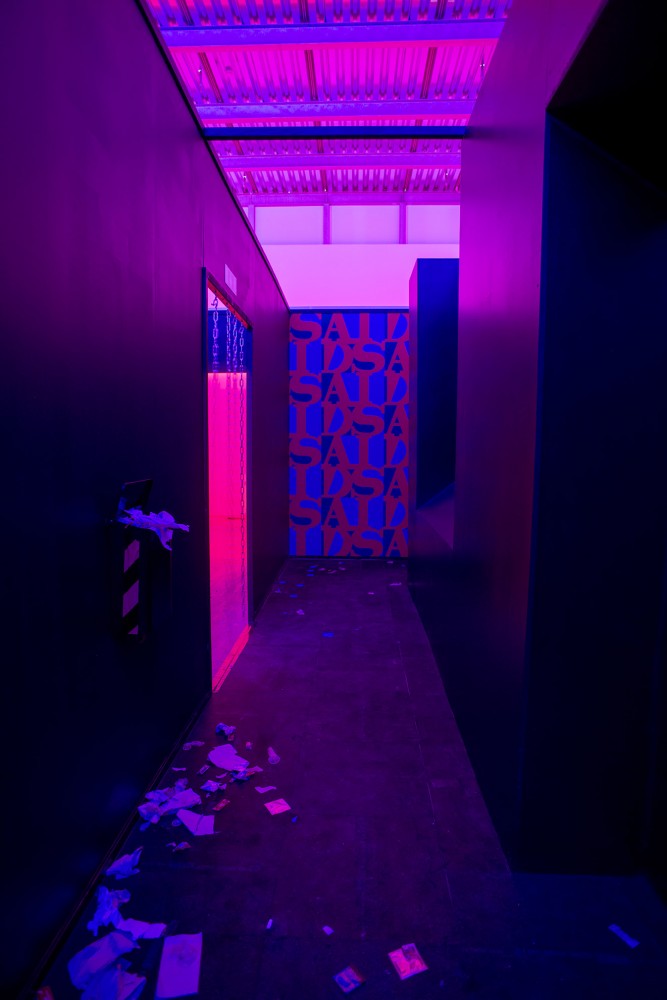
Installation view of Cruising Pavilion at ArkDes, Stockholm. Photography by Señor Image Studio.
-
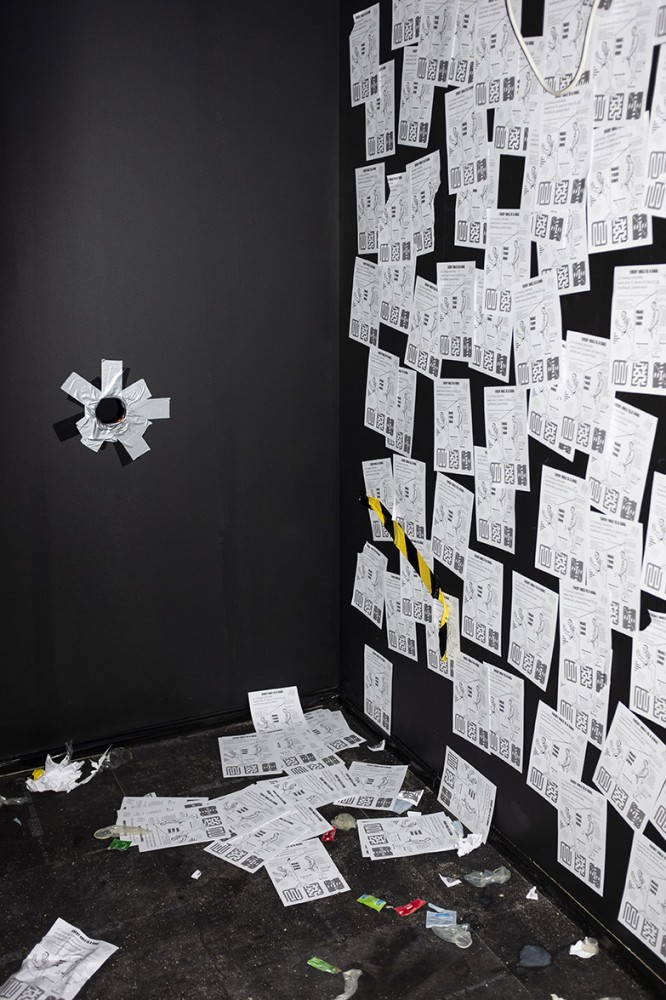
Installation view of Cruising Pavilion at ArkDes, Stockholm. Photography by Johan Dehlin.
-

Installation view of Cruising Pavilion at ArkDes, Stockholm. Photography by Señor Image Studio.
The Bar has been a crucial meeting place for the gay community for decades. In Cruising Pavilion’s version, you are greeted by Tom Burr’s Anthology: Writings 1991–2015 (2015), which the curators insist is “a gay psycho-geographical counterpart to Koolhaas’s Delirious New York.” Behind the bar hang two soccer scarfs designed by DYKE_ON, appropriating hooligan accessories to mark community through fashion. Two detailed graphic drawings by the British duo Hannah Quinlan and Rosie Hastings titled Family #1 and Family #2 (2019) reference Tom of Finland, but update the gay canon to include gender-non-conforming and trans bodies in their depiction of friends socializing in banal domestic spaces. The Bar section was rounded out with familiar works from the New York show: plans of the Saint, Gesto’s collage, and Vriesendorp’s skyscraper drawing.
-

Installation view of Cruising Pavilion at ArkDes, Stockholm. Photography by Señor Image Studio.
-

Installation view of Cruising Pavilion at ArkDes, Stockholm. Photography by Johan Dehlin.
-

Installation view of Cruising Pavilion at ArkDes, Stockholm. Photography by Señor Image Studio.
The Dark Room section was designed to imitate the lightless backrooms in nightclubs designed for anonymous encounters, including a sling and a glory hole. This exhibit may be the first time these anonymously authored objects were presented as design objects. The area around them was complete with faux used tissue and faux used condoms scattered on the floor. (The invitations to the show were also printed on a condom.) A key piece in the Dark Room was the floor-to-ceiling wallpaper titled AIDS (1990) by Canadian collective General Idea: made at a time when mainstream media could barely utter the word AIDS, the design referenced artist Robert Indiana’s iconic typography for his ubiquitous 1970 LOVE sculpture. Putting this work in the context of the Dark Room demonstrates the horrific impact the disease had on gay culture, demonizing and closing down many public spaces throughout the 1980s and early 90s. The AIDS wallpaper was cleverly juxtaposed with the reappearance of Dawson’s 20-Load Weekend: because of this pairing, the film felt more politicized than it had in the Venice show, the new context helping make clear the shift in sexual psychology that has resulted from pharmaceutical breakthroughs.
-
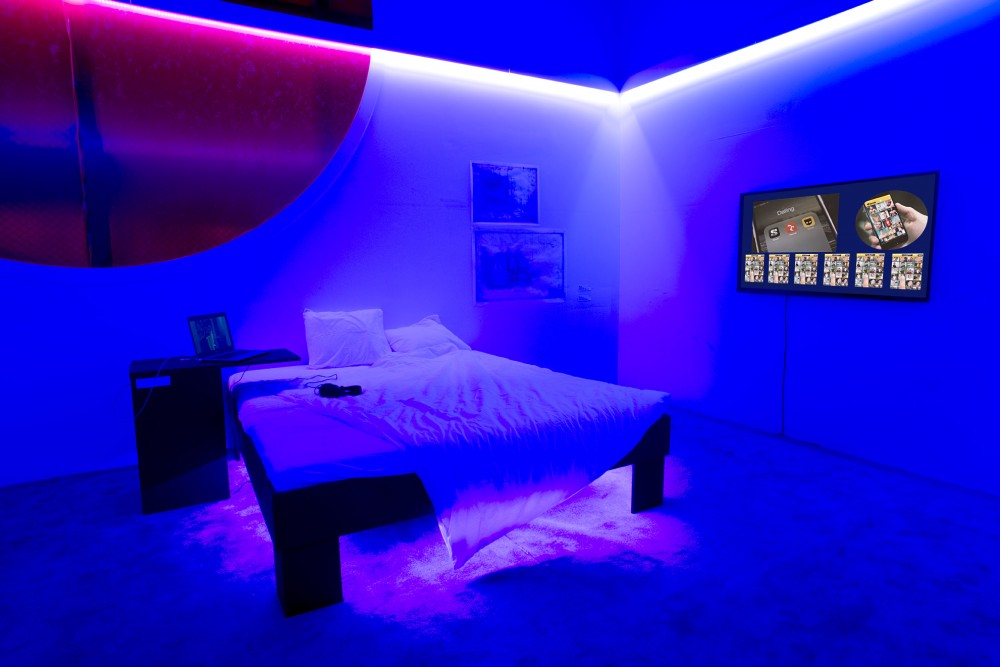
Installation view of Cruising Pavilion at ArkDes, Stockholm. Photography by Señor Image Studio.
-

Installation view of Cruising Pavilion at ArkDes, Stockholm. Photography by Señor Image Studio.
The Bedroom was the final stop in the exhibition’s three-part journey, illustrating how our smart phones and dating apps have completely transformed the experience of casual encounters. While queer people had to band together in public spaces for decades out of necessity, advancements in technology and improved social attitudes toward queer acceptance have allowed for gay men and women to be able to turn their homes into “digital bathhouses.” While older generations tend to feel that digital cruising isn’t as valid as its IRL equivalent, the exhibition’s millennial curators were not convinced of any hierarchy between the two. “Cruising has always been a game and GPS dating apps allow you to turn yourself into a character, gamifying the experience to a new heightened level,” says Mateos. Two works in particular drove the point home: Robert Yang’s Tea Room (2017), which literally turns cruising public toilets into a video game, and Andrés Jaque’s mini-documentary Intimate Strangers (2017), which recounts the social history of location-based dating apps, tracking how Grindr, a platform born out of gay desire, transformed the dynamics of mainstream sexuality and investigating its simultaneously liberating and isolating effects. As the app and its imitators connect users individually, they also inadvertently destabilize collective queer public spaces. Having had the rare opportunity of experiencing all three Cruising Pavilion exhibitions — as well the bridge project in Fire Island — I was left contemplating two crucial questions. Are queer spatial histories valuable to the greater discourses of urbanism and public space? And what is gained or lost when the act of cruising, which partially derives its magic from being illicit, outlawed, and taboo, achieves recognition from a respectable institution? I turned to a friend and architect, Charles Renfro, for his input: not only were projects by his firm Diller Scofidio + Renfro exhibited in both the Venice and Stockholm Cruising Pavilions, but he and his office have translated queer-space principles into popular public architecture in many of their high--profile designs. In addition, Renfro maintains a piece of cruising’s architectural history as the owner of one of Horace Gifford’s first Fire Island beach homes.
-

Movie posters for Treasure Island’s Dawson’s 20 Load Weekend (left) and Marguerite Duras’s Le Navire. Photography by Michael Bullock.
-

Illustration by Tom of Finland. Photography by Michael Bullock.
Cruising is intrinsic to how Renfro understands public space and its potential. After coming of age during the AIDS crisis and being “essentially celibate” throughout college, he moved to New York and “was thrilled to discover that sexually charged public spaces still existed — in parks, on the subway, in department stores, wherever a fleeting space of privacy could be found or made. These liminal spaces could be used and defined by their inhabitants on the spot.” And it’s the improvisational qualities of these spaces that inspire Renfro’s approach to design. “The High Line is essentially thought of as a cruising space. We tried not to let the architecture interfere with the experience: we kept the lighting low, the plants high, and visual access to bedrooms and bathrooms to a maximum. The Blur Building provided anonymity to everyone in its mist. The Shed was inspired by the Fun Palace, a project that aspired to be user-controlled and modified according to desire.” For Renfro, cruising’s institutionalization at ArkDes raises issues of control and prescription. While “the museum is by definition in control of the narrative,” he thinks that the exhibition “can be a catalyst for encouraging self-determined and unregulated behavior to commence once outside of its scripted walls.” Institutionalization can feel like a death knell: countercultural figures are given national honors only when they’re dead or at the very least geriatric; slang loses its vitality when it enters the dictionary. But Renfro underscores how we can take control of the narrative. Cruising is about having an ad hoc and spontaneous relationship with public space and the strangers we share it with, an act of “radical hospitality,” as Mateos and Teyssou call it. It’s up to us whether we allow technology to enhance those experiences or erase them as we move through our built environment.
Text by Michael Bullock.
Michael Bullock is a writer and independent media entrepreneur based in New York City. He is the associate publisher of PIN–UP and a contributing editor to Apartamento magazine. He also writes for Aperture, Frieze, and New York Magazine. His book Peter Berlin: Artist, Icon, Photosexual (Damiani, 2019) is out this fall.
Taken from PIN–UP 27, Fall Winter 2019/20.


